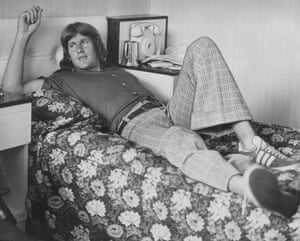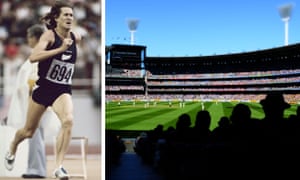I just ask you to bear with the introduction here, because it will lead you to a rare event put on at the Melbourne Cricket Club in Australia while England and Australian cricket teams were playing for the Ashes in 1977 in a meeting referred to as the Centenary. During that series of matches which obviously go on for days much like the World Series of Baseball, an exhibition mile run was set up on the grass in the Melbourne Cricket Ground where the 1956 Olympics had been held 21 years prior. The then World Record Holder and Olympic Champion at 1500 meters, John Walker of New Zealand was to be pitted against Australia's best Graham Crouch. God, that verb "pitted" must have a terrible origin. Probably comes from pit fighting of English 17th and 18th century sport in which animals were placed in a pit to have go at each other while spectators placed their bets. The rat terrier breed got its name from how many rats it could kill in a pit in a given amount of time. Anyway back to running. Here is the story, be patient going through the first part and enjoy the rest. George
Thanks to today's The Guardian April 14, 2020 by Adam Collins

It started with a tweet. On 4 March 2018, reacting to the news that barrier-busting miler Roger Bannister had died, Mike Selvey – the long-term lord of this manor – posted the following: “The great John Walker ran a sub-four-minute mile on a track laid out on the outfield of the MCG during the Centenary Test in March 1977.”
Hold up. He did what? During the most fondly recalled Test ever staged at the G?
When Google turned up nothing, my interest was piqued. I pledged to Selve – a member of that England touring squad and a trifle unlucky to miss selection after an impressive showing in the warm-up game – that I would get to the bottom of it. Well, that was more than two years ago. As is often the case current events overtook but with no such excuse anymore I went digging.
As context for those less familiar with the events of that week the occasion would still have been remarkable. Before the Test was played Wisden already declared it would be the “greatest event in cricket history”. Of the 244 living Ashes players invited to Melbourne, all but 26 made it. Jack Ryder, at 87, was the oldest Australian, dying three weeks later. His opponent from 1920-21, Percy Fender, led 79 Englishmen off their flight, the 84-year-old in a wheelchair.
The tale of the match turned out to be just as momentous, the touchstones of it requiring little further explanation: Lillee, Marsh, Willis, Hookes, Greig, McCosker, Randall, the collapses, the chase… the Queen! Oh, and that the margin was 45 runs in favour of the hosts – spookily, just as it was in the inaugural fixture they were marking from exactly 100 years before.
But let’s zero in on the third day – the one that opened the door to this Test evolving into a classic after a pair of first-innings collapses. It was on that third afternoon when the 21-year-old debutant David Hookes brashly drove and pulled the England captain Tony Greig’s off-spin to the rope five times in a row. Later, Rick McCosker emerged with a mummified face after Bob Willis broke his jaw the first time around. My dad, in attendance as a 15-year-old, remembers the crowd singing “Waltzing McCosker” as he continued hooking safely through to stumps. As he’s relayed to me many times – employing an old MCG trope – 55,399 were in the stands for this memorable day in Australian Test history but “half a million say they were”.
Before lunch, Walker – an Olympic champion nine months earlier – changed into his famous all-black running kit. At this point Selvey recalls catching his first glimpse of the mighty New Zealander’s distinctive long blond hair and thick thighs. Having won gold in the 1500m at the 1976 Montreal Olympics he was a superstar in the tradition of Trans-Tasman middle-distance giants of the previous quarter-century, from Herb Elliott and Peter Snell to Ron Clarke and John Landy. His event was unmistakably blue riband in Melbourne, the Olympic city itself in 1956.But when Walker emerged for the start of the Centenary Mile, as it was billed, it would not be alongside the man he expected – Australia’s best at the distance, Graham Crouch. The “little Australian”, as he was described on commentary during the frenetic 1974 Commonwealth Games 1500m, was also in the placings when the Kiwi became the first man to break 3:50 for the mile in 1975 and then trailed Walker in his successful Olympic final in 1976. He elected to sit out the race, watching from the stands. Ken Hall, the national champion from only three days earlier, did likewise, citing exhaustion.
The field of four Walker had left were, The Age described, “willing but weak” by comparison. Combined with blustery conditions and a grass track, the organisers’ hopes of a sub-four-minute time were dashed. The champion sat back before going to work in the final 300m, newspaper reports saying he bolted in by 30m in 4:05. One of the other runners, Dr Peter Larkins – an Olympian who went on to enjoy a distinguished career as a sports physician after retiring from the track – agrees it was not the mix of conditions required for a rapid pace.
Memories of Walker’s storming finish, with a final lap of 54sec, tallies with the recollection of Jim Maxwell – 26 at the time – who then had just called his first of more than 300 Tests the month before. He made the trip partly to work but mostly to socialise, as he did with John Arlott and Alan McGilvray, the man from whom Maxwell would later inherit the tag as the voice of Australian cricket. “When you saw him you had to stop,” he recalls of the race. “You didn’t turn your head. You just watched because he was a very attractive athlete.”
Walker’s disappointment in his rival Crouch was unmistakable, calling it a “very bad show” from the local lad. “Graham is supposed to be the best runner in Australia,” he said. “The crowd expected him to run and he should have run.” But Dr Larkins’ perspective is that this was simply reflective of their competitive relationship. For taking part in the race, they all received a brass wine goblet in which Larkins keeps his pens at home to this day.
“It always surprises people when I say the biggest crowd that I ran in front of was not at the Olympics but at the MCG during the cricket! And I have very fond memories of John. He was the track star. It was not my most glorious performance but it was such an honour.”
After finding out all there was on the public record and talking to those who remembered it – not even the illustrious MCG Library has formal documentation of the race – Walker (Sir John, since 2009) kindly agreed to talk to The Spin from his home in Auckland. He might have slowed down over the past two decades owing to Parkinson’s disease but it has not lessened his broader contribution, a decade as a local government councillor only ending last October on retiring at 67.
“You are the first person to bring it up with me for over 40 years,” Walker began. He was understandably reluctant to reflect on what happened that day with his old sparring partner Crouch, who died from cancer last year, instead focusing on the honour of performing in front of packed grandstands.
“I remember going down the back straight being a fair way behind and realising that if I didn’t get into gear I wasn’t going to catch them. So, I took off and won quite easily in the end. Thank you for bringing it up.”
Walker would not top his 1976 triumph, thwarted by injury and then a boycott, which denied him a chance to defend his Olympic crown in 1980. He never stopped running the mile, becoming the first to break four minutes on 100 occasions in 1985 and going on to do so 135 times.
As for Selvey he is pleased his affinity with New Zealand and running did not collude to trick him into believing something that wasn’t. “I thought it might have been something I wanted to have happened,” he says. “There didn’t seem to be any recollection from anyone.” Well, there is now.
Signing off from the telecast, Frank Tyson described the Centenary Test as “the Olympic Games of cricket”. What’s irrefutable is that Olympic spirit did return to a cricket ground that magnificent week, through one of the greatest of them all.
• This is an extract from the Guardian’s weekly cricket email, The Spin. To subscribe, just visit this page and follow the instructions.





No comments:
Post a Comment